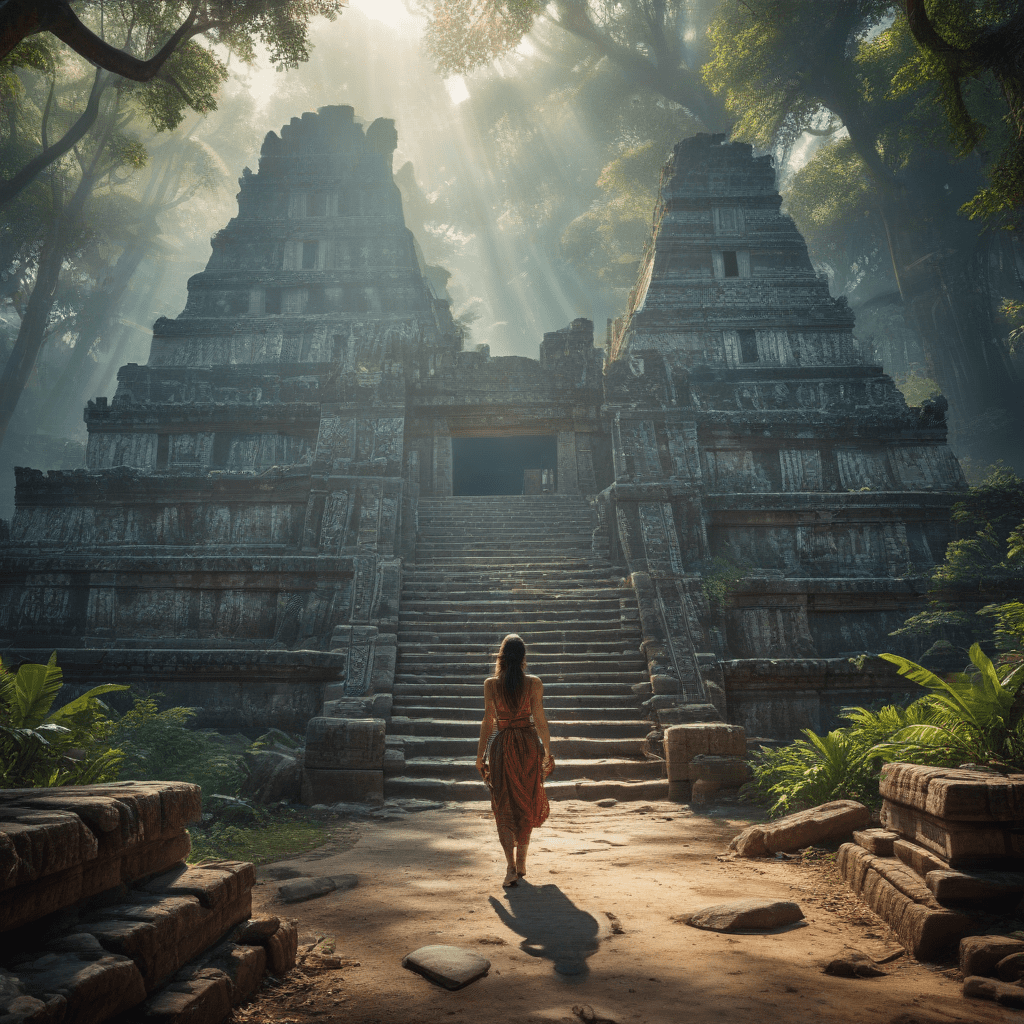1. Introduction
The ancient Maya civilization, once thrived in the lush rainforests and arid lowlands of Mesoamerica, left behind a legacy of awe-inspiring structures, among which their sacred temples stand as testaments to their profound connection to the cosmos, their intricate mythology, and their advanced architectural prowess. These temples, far more than mere places of worship, served as astronomical observatories, political centers, and gateways to the underworld, embodying the very essence of Mayan life and beliefs.
In this exploration, we delve into the enigmatic world of Mayan sacred temples, unraveling their mysteries and shedding light on their significance. From the creation myth that fueled their construction to the symbolism embedded in their design, we embark on a journey through the rituals, sacrifices, and astronomical observations that defined Mayan spirituality. We investigate the theories surrounding their purpose and meaning, and explore the ongoing efforts to preserve and protect these irreplaceable treasures.
Join us as we unlock the secrets of these magnificent structures, revealing the fascinating story of a civilization that reached for the stars and left behind an enduring legacy for future generations to admire and decipher.
6. The Afterlife and Underworld
The Mayans believed in a complex and multifaceted afterlife, where the journey of the soul was intricately linked to the symbolism and rituals associated with their temples. The descent into the underworld, known as Xibalba, was a perilous undertaking, fraught with challenges and obstacles that the deceased had to overcome to reach their final destination. Temples often served as symbolic representations of this underworld journey, with their intricate passageways and chambers mirroring the trials and tribulations faced by the soul.
Burial rituals played a significant role in Mayan beliefs about the afterlife. The deceased were often interred within or beneath temple structures, accompanied by offerings of food, ceramics, and other precious objects that were believed to aid them in their journey. These offerings reflected the Mayans' belief in the continuity of life after death and the importance of providing for the deceased in the afterlife.
7. Theories and Interpretations
Over the years, numerous theories and interpretations have emerged regarding the purpose and meaning of Mayan temples. Some scholars argue that they primarily served as astronomical observatories, while others emphasize their role as political and social centers. Still, others believe that they were primarily religious sanctuaries dedicated to specific deities or rituals.
The ongoing research and archaeological discoveries continue to shed new light on the complexities of Mayan culture and beliefs. Recent studies have revealed intricate astronomical alignments in temple architecture, suggesting their use as sophisticated tools for tracking celestial events. The discovery of hidden chambers and passageways within temples has also provided valuable insights into the rituals and ceremonies that took place within these sacred spaces.
8. Preservation and Conservation
The preservation and conservation of Mayan temples are of paramount importance for safeguarding this irreplaceable cultural heritage for future generations. Exposure to the elements, vegetation growth, and human activity pose significant threats to the integrity of these ancient structures. Conservation efforts involve meticulous documentation, restoration work, and the implementation of sustainable tourism practices to minimize the impact of visitors.
International organizations, governments, and local communities are collaborating to ensure the long-term preservation of Mayan archaeological sites. Through careful monitoring, conservation techniques, and raising awareness about the importance of cultural heritage, these magnificent structures will continue to stand as testaments to the ingenuity and achievements of the Mayan civilization.
9. Conclusion
Mayan sacred temples stand as enduring symbols of a civilization that sought to understand the universe, connect with the divine, and navigate the mysteries of life and death. By unraveling their secrets, we gain a deeper appreciation for the rich cultural heritage of the Mayans and the profound impact they have had on our understanding of the ancient world. As we continue to explore and learn from these awe-inspiring structures, we are reminded of the enduring power of human curiosity, creativity, and the enduring legacy that we leave behind.
10. FAQ
Q: What is the significance of the number 9 in Mayan culture?
A: The number 9 held great importance in Mayan mythology and cosmology. It represented the underworld, the night, and the completion of cycles. It was also associated with the rain god Chaac and the planet Venus.
Q: What are some of the most famous Mayan temples?
A: Some of the most famous Mayan temples include the Pyramid of Kukulkan at Chichen Itza, the Temple of the Inscriptions at Palenque, and the Temple of the Giant Jaguar at Tikal.
Q: How did the Mayans use their temples as astronomical observatories?
A: The Mayans carefully aligned their temples with celestial events, such as solstices and equinoxes. They used the position of the sun, moon, and stars to track time, predict agricultural cycles, and perform religious ceremonies.
Q: What are some of the challenges faced in preserving Mayan temples?
A: Some of the challenges faced in preserving Mayan temples include exposure to the elements, vegetation growth, human activity, and looting. Conservation efforts involve meticulous documentation, restoration work, and the implementation of sustainable tourism practices.


